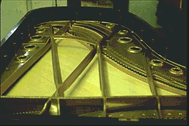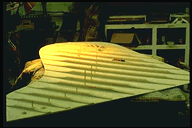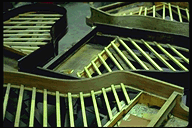


 |
 |
 |
A new soundboard is required if the old soundboard has the following indicators:
If you really just want to see pictures of a soundboard being built, then take a shortcut and view many pictures...HERE..
It is very important to buy a very good soundboard panel and good rib stock. Fortunately, excellent materials are available (if you know how to order only the best) and more often than not exceed the quality of the original materials. While very expensive, it is always better to start with the very best, whether it be soundboards, pinblocks, or hammers and action parts.
As a test, one can throw an intended soundboard rib stock sample onto the cement floor of the shop. The resulting tone of the "clattering" and bouncing piece of wood on the floor will give an indication as to its suitability. If it sounds tuneful and colorful, then this is a good indication. If it sounds dull and lifeless....it is best to scrap that board and cut a new one.
A new soundboard is properly "crowned" to support the 16 to 20 tons of weight from the strings by three critical operations:
Another important operation is to make the soundboard "diaphragmatic" or to "feather" the thickness of the soundboard like a violin top so that it can vibrate freer. All Steinway grand pianos have this decrease in thickness for about six inches from the side of the rim all the way around stopping towards the treble. If the treble is thinned then a weak treble tone results.
When the soundboard and ribs are dried back down to 5% moisture content then gluing the ribs to the soundboard is done. This is accomplished by placing the soundboard on the specially constructed "belly board" that has the right amount of curvature cut into it. The ribs should also be cut with the same curvature but often rebuilders omit this important procedure and risk a resultant loss of crown.. After the soundboard is "ribbed" then other numerous and intricate operations must be performed before the soundboard can be dried back down and finally glued into the case. A good quantity of expensive clamps are required.
It is important to completely control the humidity of the room in which the soundboard is made. If the moisture content of the room is not raised to 40% when the soundboard is glued into the case or ribbed then the crown will not form reliably. Complete control of the room humidity is essential. Proper soundboard crown is created by the following:
1.) Proper curvature of the belly board
2.) Cutting the curvature of the crown into the ribs themselves.
3.) Moisture crowning. Allowing the increase in room moisture to force the soundboard into the crowned position.
None of these three items can be omitted without risking a premature loss of crown of the new soundboard.
Sometimes a customer will insist on trying to save a soundboard that should be replaced. While I try to talk them out of it, they have a sentimental regard for their old and tired soundboard and will pay for the risky job of putting it back together. A small air die grinder can be used to cut out the bad parts of the soundboard so new instrument wood can be inserted. I prefer to make such a repair to only one or two cracks in the soundboard. Often a soundboard is in good shape except for a few cracks. If you wish to see a true "nightmare" repair job to a Steinway B please look at the following pictures.
For more information e-mail: garynbrownfield@comcast.net